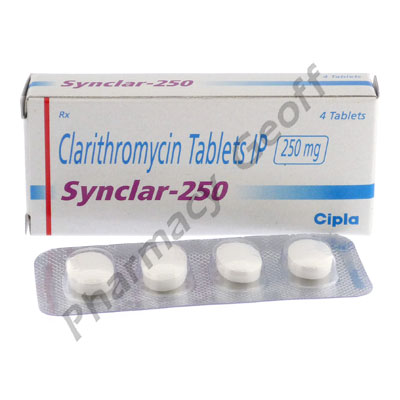
Treatment of Disseminated MAC Disease One randomized, double blind clinical trial (Study 189) was performed in patients with disseminated MAC. In this trial, 246 HIV infected patients with disseminated MAC received either azithromycin 250 mg qd (N=65), azithromycin 600 mg qd (N=91) or clarithromycin 500 mg bid (N=90), each administered with ethambutol 15 mg/kg qd, for 24 weeks. Patients were cultured and clinically assessed every 3 weeks through week 12 and monthly thereafter through week 24. After week 24, patients were switched to any open label therapy at the discretion of the investigator and followed every 3 months through the last follow up visit of the trial. Patients were followed from the baseline visit for a period of up to 3.7 years (median: 9 months).

MAC isolates recovered during study treatment or post-treatment were obtained whenever possible. The primary endpoint was sterilization by week 24. Sterilization was based on data from the central laboratory, and was defined as two consecutive observed negative blood cultures for MAC, independent of missing culture data between the two negative observations. Analyses were performed on all randomized patients who had a positive baseline culture for MAC. The azithromycin 250 mg arm was discontinued after an interim analysis at 12 weeks showed a significantly lower clearance of bacteremia compared to clarithromycin 500 mg bid. Efficacy results for the azithromycin 600 mg qd and clarithromycin 500 mg bid treatment regimens are described in the following table.
Azithromycin 600 mg (N = 68) Clarithromycin 500 mg bid (N = 57) Groups Stratified by MAC Colony Counts at Baseline No. (%) Subjects in Stratified Group Sterile at Week 24 No. (%) Subjects in Stratified Group Sterile at Week 24 ≤ 10 cfu/mL 10/15 (66.7%) 12/17 (70.6%) 11-100 cfu/mL 13/28 (46.4%) 13/19 (68.4%) 101-1,000 cfu/mL 7/19 (36.8%) 5/13 (38.5%) 1,001-10,000 cfu/mL 1/5 (20.0%) 1/5 (20%) 10,000 cfu/mL 0/1 (0.0%) 1/3 (33.3%) Susceptibility Pattern of MAC IsolatesSusceptibility testing was performed on MAC isolates recovered at baseline, at the time of breakthrough on therapy or during post-therapy follow-up. The T100 radiometric broth method was employed to determine azithromycin and clarithromycin MIC values.
Clarithromycin Or Azithromycin For Macbook Air
Azithromycin MIC values ranged from 256 mcg/mL and clarithromycin MICs ranged from 32 mcg/mL. The individual MAC susceptibility results demonstrated that azithromycin MIC values could be 4 to 32 fold higher than clarithromycin MIC values.During study treatment and post-treatment follow up for up to 3.7 years (median: 9 months) in study 189, a total of 6/68 (9%) and 6/57 (11%) of the patients randomized to azithromycin 600 mg daily and clarithromycin 500 mg bid, respectively, developed MAC blood culture isolates that had a sharp increase in MIC values. All twelve MAC isolates had azithromycin MIC’s ≥256 mcg/mL and clarithromycin MIC’s 32 mcg/mL. These high MIC values suggest development of drug resistance. However, at this time, specific breakpoints for separating susceptible and resistant MAC isolates have not been established for either macrolide. ANIMAL TOXICOLOGY Phospholipidosis (intracellular phospholipid binding) has been observed in some tissues of mice, rats, and dogs given multiple doses of azithromycin.
It has been demonstrated in numerous organ systems (e.g., eye, dorsal root ganglia, liver, gallbladder, kidney, spleen, and pancreas) in dogs administered doses which, based on pharmacokinetics, are as low as 2 times greater than the recommended adult human dose and in rats at doses comparable to the recommended adult human dose. This effect has been reversible after cessation of azithromycin treatment. The significance of these findings for humans is unknown. REFERENCES:. National Committee for Clinical Laboratory Standards.
Methods for Dilution Antimicrobial Susceptibility Tests for Bacteria that Grow Aerobically-Third Edition. Approved Standard NCCLS Document M7-A3, Vol. 25, NCCLS, Villanova, PA, December 1993. National Committee for Clinical Laboratory Standards. Performance Standards for Antimicrobial Disk Susceptibility Tests-Fifth Edition.
Approved Standard NCCLS Document M2-A5, Vol. 24, NCCLS, Villanova, PA, December 1993. Dunne MW, Foulds G, Retsema JA.
Rationale for the use of azithromycin as Mycobacterium avium chemoprophylaxis. American J Medicine 1997; 102(5C):37-49. Meier A, Kirshner P, Springer B, et al.
Identification of mutations in 23S rRNA gene of clarithromycin-resistant Mycobacterium intracellulare. Antimicrob Agents Chemother. Methodology per Inderlied CB, et al. Determination of In Vitro Susceptibility of Mycobacterium avium Complex Isolates to Antimicrobial Agents by Various Methods.
Antimicrob Agents Chemother 1987; 31:1697-1702. Manufactured by: Wockhardt Limited Mumbai, India.
Distributed by: Wockhardt USA LLC. 20 Waterview Blvd. Parsippany, NJ 07054 USA.

